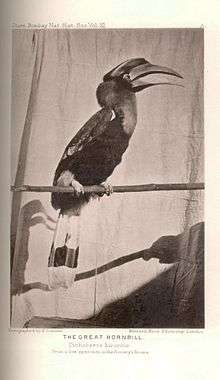Bombay Natural History Society
 | |
| Headquarters | Hornbill House, Mumbai (Bombay), India |
|---|---|
| Location |
|
Region served | India |
| Website |
bnhs |
.jpg)
The Bombay Natural History Society, founded on 15 September 1883, is one of the largest non-governmental organisations in India engaged in conservation and biodiversity research.[1] It supports many research efforts through grants and publishes the Journal of the Bombay Natural History Society. Many prominent naturalists, including the ornithologists Sálim Ali and S. Dillon Ripley, have been associated with it.[2] The society is commonly known by its initials, BNHS. BNHS is the partner of BirdLife International in India. It has been designated as a 'Scientific and Industrial Research Organisation' by the Department of Science and Technology.
History

On September 15, 1883 eight men interested in natural history met at Bombay in the then Victoria and Albert Museum (now Bhau Daji Lad Museum) and:[3]
constituted themselves as the Bombay Natural History Society. They proposed to meet monthly and exchange notes, exhibit interesting specimens and otherwise encourage each other.
According to E. H. Aitken (the first honorary secretary, September 1883-March 1886), Dr G. A. Maconochie was the fons et origo (Latin for "source and origin") of the society. The other founders were Dr D. MacDonald, Col. C. Swinhoe, Mr J. C. Anderson, Mr J. Johnston, Dr Atmaram Pandurang and Dr Sakharam Arjun.[4] Mr H. M. Phipson (second honorary secretary, 1886–1906) was a part of the founding group. He lent a part of his wine shop at 18 Forbes Street to the BNHS as an office.[5]
In 1911, R. C. Wroughton a BNHS member and forest officer organised a survey of mammals making use of the members spread through the Indian subcontinent to provide specimens. This was perhaps the first collaborative natural history study in the world. It resulted in a collection of 50,000 specimens in 12 years. Several new species were discovered, 47 publications were published, and the understanding of biogeographic boundaries was improved.[6]
In the early years, the Journal of the BNHS reviewed contemporary literature from other parts of the world. The description of ant-bird interactions in German by Erwin Stresemann was reviewed in a 1935 issue leading to the introduction of the term anting into English.
Today the BNHS is headquartered in the specially constructed 'Hornbill House' in southern Mumbai. It sponsors studies in Indian wildlife and conservation, and publishes a four-monthly journal, Journal of the Bombay Natural History Society (JBNHS), as well as a quarterly magazine, Hornbill.
BNHS logo
The BNHS logo is the great hornbill, inspired by a great hornbill named William, who lived on the premises of the Society from 1894 until 1920, during the honorary secretaryships of H. M. Phipson until 1906 and W. S. Millard from 1906 to 1920.[7] The logo was created in 1933, the silver-jubilee year of the Society's founding.
William
According to H. M. Phipson, William was born in May 1894 and presented to the Society three months later by H. Ingle of Karwar. He reached his full length (4.25 feet (1.30 m) by the end of his third year. His diet consisted of fruit, (like plantains and wild figs) and also of live mice, scorpions, and plain raw meat, which he ate with relish.[7] He apparently did not drink water, nor use it for bathing.[7] William was known for catching tennis balls thrown at him from a distance of some 30 feet with his beak.[7]
In his obituary of W. S. Millard, Sir Norman Kinnear made the following remarks about William:[8]
| “ | Every visitor to the Society's room in Appollo Street will remember the great Indian Hornbill, better known as the "office canary" which lived in a cage behind Millard's chair in Phipson & Co.'s office for 26 years and died in 1920. It is said its death was caused by swallowing a piece of wire, but in the past "William" had swallowed a lighted cigar without ill effects and I for my part think that the loss of his old friend was the principal cause. | ” |
-

Profile by E. Comber (1897) of the great Indian hornbill, "William," who lived on the premises of the society from 1894 until 1920, and who would later be the model for its logo.
-

Another photograph of "William," by E. Comber published in the Journal of the Bombay Natural History Society, 1897.
See also
- Conservation in India
- Conservation Education Centre of the BNHS
References
- ↑ Organizations: India. US Library of Congress, Portals to the World. Retrieved 3 December 2006.
- ↑ BNHS:Mission and Vision, Bombay Natural History Society. Retrieved 3 December 2006.
- ↑ Aitken, E.H.; Sterndale, R. A., eds. (January 1886). "Introduction" (PDF). Journal of the Bombay Natural Society. Bombay: Education Society's Press. 1 (1).
- ↑ Rachel Reuben (2005) The Indian Founders. Hornbill (Apr-Jun): pp.13-15
- ↑ Ali, Salim (1978). "The founders, the builders and the guardians. Part I.". Journal of the Bombay Natural History Society. 75 (3): 559–569.
- ↑ Newton, Paul & Matt Ridley. Biology under the Raj. New Scientist. (22 September 1983) pp. 857-867
- 1 2 3 4 Phipson, H M (1897). "The Great Indian Hornbill in captivity". Journal of the Bombay Natural History Society. 11 (2): 307–308.
- ↑ Kinnear, Norman B (1952). "W. S. Millard". Journal of Bombay Nat. Hist. Soc. 50: 910–913.
Further reading
- Ali, Salim (1978). "Bombay Natural History Society — The Founders, the Builders and the Guardians. Part 1". Journal of the Bombay Natural History Society. 75 (3): 559–569.
- Ali, Salim (1981). "Bombay Natural History Society — The Founders, the Builders and the Guardians. Part 2". Journal of the Bombay Natural History Society. 78 (2): 232–239.
External links
- Official website
- Conservation Education Centre -- Education wing of the BNHS
- Wild enthusiasm Sarika Mehta, March 18, 2005, The Hindu Business Line